Analysis of the Ecosystem Characteristics and Ecological Carrying Capacity of the Main Commercial Fish in the Artificial Reef Ecosystem in Laizhou Bay Using the Ecopath Model
Abstract
:1. Introduction
2. Materials and Methods
2.1. Study Area
2.2. Ecopath Approach
2.3. Structure of the Model
2.4. Input Parameters of Functional Groups
2.5. Model Balancing and Uncertainty
2.6. Ecosystem Attributes
2.7. Ecological Carrying Capacity Assessments
3. Results
3.1. Balancing the Model and Trophic Structure
3.2. Transfer Efficiencies
3.3. Mixed Trophic Impacts
3.4. Niche Overlap Analysis
3.5. Ecosystem Analysis and Indicators
3.6. Ecological Carrying Capacity Assessment
4. Discussion
5. Conclusions
Supplementary Materials
Author Contributions
Funding
Institutional Review Board Statement
Informed Consent Statement
Data Availability Statement
Acknowledgments
Conflicts of Interest
References
- Li, Y.; Yong, C.; Olson, D.; Yu, N.; Chen, L.Q. Evaluating ecosystem structure and functioning of the East China Sea Shelf ecosystem, China. Hydrobiologia 2009, 636, 331–351. [Google Scholar] [CrossRef]
- Pauly, D.; Christensen, V.; Dalsgaard, J.; Froese, R.; Torres, F., Jr. Fishing down marine food webs. Science 1998, 279, 860–863. [Google Scholar] [CrossRef] [PubMed]
- Hutchings, J.A.; Reynolds, J.D. Marine fish population collapses: Consequences for recovery and extinction risk. BioScience 2004, 54, 297–309. [Google Scholar] [CrossRef]
- Yang, H.S.; Da, H.; Xu, Q. Views on modern marine ranching. Oceanol. Limnol. Sin. 2016, 47, 1069–1074. (In Chinese) [Google Scholar] [CrossRef]
- Yang, H.S. Construction of marine ranching in China: Reviews and prospects. J. Fish. China 2016, 40, 1133–1140. (In Chinese) [Google Scholar] [CrossRef]
- Li, Z.Y.; Lin, Q.; Li, J.; Shan, X.J. Present situation and future development of marine ranching construction in China. J. Fish. China 2019, 43, 1870–1880. (In Chinese) [Google Scholar] [CrossRef]
- Myoung, J.G.; Park, Y.J. Monthly changes of fish fauna at experimental artificial reef in Tongyeong marine ranching area, Korea. Ocean Polar Res. 2001, 23, 311–313. [Google Scholar]
- Stottrup, J.G.; Sparrevohn, C.R. Can stock enhancement enhance stocks? J. Sea Res. 2007, 57, 104–113. [Google Scholar] [CrossRef]
- Blaxter, J.H.S. The enhancement of marine fish stocks. Adv. Mar. Biol. 2000, 38, 1–54. [Google Scholar] [CrossRef]
- Einum, S.; Fleming, I.A. Implications of stocking: Ecological interactions between wild and released salmonids. Nordic J. Freshw. Res. 2001, 75, 56–70. [Google Scholar]
- Leber, K.M. Advances in marine stock enhancement: Shifting emphasis to theory and accountability. In Responsible Marine Aquaculture; Stickney, R.R., McVey, J.P., Eds.; CABI Publishing: New York, NY, USA, 2002; pp. 79–90. [Google Scholar]
- Lorenzen, K. Understanding and managing enhancement fisheries systems. Rev. Fish. Sci. 2008, 16, 10–23. [Google Scholar] [CrossRef]
- Bell, J.D.; Laber, K.M.; Blankenship, H.L.; Loneragan, N.R.; Masuda, R. A new era for restocking, stock enhancement and sea ranching of coastal fisheries resources. Rev. Fish. Sci. 2008, 16, 1–9. [Google Scholar] [CrossRef]
- Lorenzen, K.; Agnalt, A.L.; Blankenship, H.L.; Hines, A.H.; Leber, K.M.; Loneragan, N.R.; Taylor, M.D. Evolving context and maturing science: Aquaculture-based enhancement and restoration enter the marine fisheries management toolbox. Rev. Fish. Sci. 2013, 21, 213–221. [Google Scholar] [CrossRef]
- Lorenzen, K.; Leber, K.M.; Blankenship, H.L. Responsible approach to marine stock enhancement: An update. Rev. Fish. Sci. 2010, 18, 189–210. [Google Scholar] [CrossRef]
- Odum, E.P. The strategy of ecosystem development. Science 1969, 164, 262–270. [Google Scholar] [CrossRef] [Green Version]
- Lin, Q.; Jin, X.S.; Zhang, B.; Guo, X.W. Study on the changes of the Bohai Sea ecosystem structure based on Ecopath model between ten years. Acta Ecol. Sin. 2009, 29, 3613–3620. (In Chinese) [Google Scholar] [CrossRef]
- Christensen, V. Ecosystem maturity—Towards quantification. Ecol. Model. 1995, 77, 3–32. [Google Scholar] [CrossRef]
- Christensen, V.; Walters, C.J.; Pauly, D. Ecopath with Ecosim: A User’s Guide; Fisheries Centre, University of British Columbia: Vancouver, BC, Canada, 2005; Volume 154. [Google Scholar]
- Jiang, W.M.; Gibbs, M.T. Predicting the carrying capacity of bivalve shellfish culture using a steady, linear food web model. Aquaculture 2005, 244, 171–185. [Google Scholar] [CrossRef]
- Luis, O.; Carrie, B.; Ronaldo, A. Ecosystem maturity as a proxy of mussel aquaculture carrying capacity in Ria de Arousa (NW Spain): A food web modeling perspective. Aquaculture 2018, 496, 270–284. [Google Scholar] [CrossRef]
- Zhang, H.J.; Liu, S.D.; Liu, Y.J.; Tu, Z.; Zhou, Q.L.; Chen, W.; Sun, W.; Li, F. Community structure of nektons in Laizhou Bay, China. Mar. Sci. 2020, 44, 110–121. (In Chinese) [Google Scholar] [CrossRef]
- Jin, X.S.; Deng, J.Y. Variations in community structure of fishery resources and biodiversity in the Laizhou Bay. Chin. Biodivers. 2000, 8, 65–72. (In Chinese) [Google Scholar] [CrossRef]
- Xu, M.; Qi, L.; Zhang, L.B.; Zhang, T.; Yang, H.S.; Zhang, Y.L. Ecosystem attributes of trophic models before and after construction of artificial oyster reefs using Ecopath. Aquacult. Environ. Interact. 2019, 11, 111–127. [Google Scholar] [CrossRef]
- Lin, Q.; Li, X.S.; Li, Z.Y.; Jin, X.S. Ecological carrying capacity of Chinese shrimp stock enhancement in Laizhou Bay of East China based on Ecopath model. Chin. J. Appl. Ecol. 2013, 24, 1131–1140. Available online: http://www.cjae.net/CN/abstract/abstract10679.shtml (accessed on 12 May 2022). (In Chinese).
- Yang, C.J.; Wu, Z.X.; Liu, H.Y.; Zhang, P.D.; Li, W.T.; Zeng, X.Q.; Zhang, X.M. The fishing strategy of Charybdis japonica and Rapana venosa and the carrying capacity of Apostichopus japonucus in Zhuwang, Laizhou artificial reef ecosystem based on Ecopath model. J. Ocean Univ. China 2016, 46, 168–177. (In Chinese) [Google Scholar] [CrossRef]
- Zhang, M.L.; Leng, Y.S.; Lv, Z.B.; Li, F.; Wang, T.T.; Zhang, A.B. Estimating the ecological carrying capacity of Portunus trituberculatus in Laizhou Bay. Mar. Fish. 2013, 35, 303–308. (In Chinese) [Google Scholar] [CrossRef]
- Christensen, V.; Pauly, D. Trophic Models of Aquatic Ecosystems; ICLARM Conference Proceedings 26; WorldFish: Manila, Philippines, 1993; p. 390. [Google Scholar]
- Sandu, C.; Iacob, R.; Nicolescu, N. Chlorophyll-a determination—A reliable method for phytoplankton biomass assessment. Acta Biol. Hung. 2003, 45, 389–397. [Google Scholar] [CrossRef]
- Jones, J.G. A Guide to Methods for Estimating Microbial Number Sand Biomass in Freshwater; Freshwater Biological Association, Scientific Publication: Ambleside, Cumbria, UK, 1979; p. 108. [Google Scholar]
- Ju, P.L.; Cheung, W.W.L.; Chen, M.; Xian, W.W.; Yang, S.Y.; Xiao, J.M. Comparing marine ecosystems of Laizhou and Haizhou Bays, China, using ecological indicators estimated from food web models. J. Mar. Syst. 2020, 202, 103238. [Google Scholar] [CrossRef]
- Allen, K.R. Relation between production and biomass. Can. J. Fish. Aquat. Sci. 1971, 28, 1573–1581. [Google Scholar] [CrossRef]
- Banse, K.; Mosher, S. Adult body mass and annual production/biomass relationships of field populations. Ecol. Monogr. 1980, 50, 355–379. [Google Scholar] [CrossRef]
- Huang, M.Y.; Xu, S.N.; Liu, Y.; Xiao, Y.Y.; Wang, T.; Li, H.C. Assessment of ecological carrying capacity of Sparus macrocephalus in Daya Bay based on an Ecopath model. J. Fish. Sci. China 2019, 26, 1–13. (In Chinese) [Google Scholar] [CrossRef]
- Link, J.S. Adding rigor to ecological network models by evaluating a set of pre-balance diagnostics: A plea for PREBAL. Ecol. Model. 2010, 221, 1580–1591. [Google Scholar] [CrossRef]
- Heymans, J.J.; Coll, M.; Link, J.S.; Mackinson, S.; Steenbeek, J.; Walters, C.; Christensen, V. Best practice in Ecopath with Ecosim food-web models for ecosystem-based management. Ecol. Model. 2016, 331, 173–184. [Google Scholar] [CrossRef]
- Zeng, Y.; Zhao, Y.W.; Qi, Z.F. Evaluating the ecological state of Chinese Lake Baiyangdian (BYD) based on ecological network analysis. Ecol. Indic. 2021, 127, 107788. [Google Scholar] [CrossRef]
- Finn, J.T. Measures of ecosystem structure and function derived from analysis of flows. J. Theor. Biol. 1976, 56, 363–380. [Google Scholar] [CrossRef]
- Ulanowicz, R.E.; Puccia, C.J. Mixed trophic impacts in ecosystems. Coenoses 1990, 5, 7–16. [Google Scholar]
- Zhang, X.; Zhang, Y.; Sun, H.; Xia, D.X. Changes of hydrological environment and their influences on coastal wetlands in the southern Laizhou Bay, China. Environ. Monit. Assess. 2006, 119, 97–106. [Google Scholar] [CrossRef] [PubMed]
- Chen, Z.Z.; Qiu, Y.S.; Jia, X.P.; Xu, S.N. Using an ecosystem modeling approach to explore possible ecosystem impacts of fishing in the Beibu Gulf, Northern South China Sea. Ecosystems 2008, 11, 1318–1334. [Google Scholar] [CrossRef]
- Han, D.Y.; Xue, Y.; Zhang, C.L.; Ren, Y.P. A mass balanced model of trophic structure and energy flows of a semi-closed marine ecosystem. Acta Oceanol. Sin. 2017, 36, 60–69. [Google Scholar] [CrossRef]
- Wang, T.; Li, Y.K.; Xie, B.; Zhang, H.; Zhang, S. Ecosystem development of Haizhou Bay ecological restoration area from 2003 to 2013. J. Ocean Univ. China 2017, 16, 1126–1132. [Google Scholar] [CrossRef]
- Xu, S.N.; Chen, Z.Z.; Li, S.Y.; He, P.M. Modeling trophic structure and energy flows in a coastal artificial ecosystem using mass-balance Ecopath model. Estuar. Coast. 2011, 34, 351–363. [Google Scholar] [CrossRef]
- Cheng, J.H.; Cheung, W.W.L.; Pitcher, T.J. Mass-balance ecosystem model of the East China Sea. Prog. Nat. Sci. Mater. 2009, 19, 1271–1280. [Google Scholar] [CrossRef]
- Bohnsack, J.A. Are high-densities of fishes at artificial reefs the result of habitat limitation or behavioral preference? Bull. Mar. Sci. 1989, 44, 631–645. [Google Scholar]
- Mace, P.M. A new role for MSY in single-species and ecosystem approaches to fisheries stock assessment and management. Fish Fish. 2001, 2, 2–32. [Google Scholar] [CrossRef]
- Li, X.; Yang, W.; Li, S.; Sun, T.; Bai, J.; Pei, J. Asymmetric responses of spatial variation of different communities to a salinity gradient in coastal wetlands. Mar. Environ. Res. 2020, 158, 105008. [Google Scholar] [CrossRef] [PubMed]
- Li, X.; Yang, W.; Sun, T.; Gaedke, U. Quantitative food web structure and ecosystem functions in a warm-temperate seagrass bed. Mar. Biol. 2021, 168, 74. [Google Scholar] [CrossRef]
- Liu, X.S.; Zhao, R.; Hua, E.; Lu, L.; Zhang, Z.N. Macrofaunal community structure in the Laizhou Bay in summer and the comparison with historical data. Mar. Sci. Bull. 2014, 33, 10. [Google Scholar] [CrossRef]
- Zhuang, L.C.; Ye, Z.J.; Li, J. Age and growth studies of Sebastes schlegelii in Qingdao coastal waters. Period. Ocean Univ. China 2015, 45, 32–37. (In Chinese) [Google Scholar] [CrossRef]
- Ji, D.P. Study on the Fishery Biology of Hexagrammos agrammus and Hexagrammos otakii in Lidao Rongcheng. Ph.D. Theies, China Ocean University, Qingdao, China, 2014. (In Chinese). [Google Scholar]
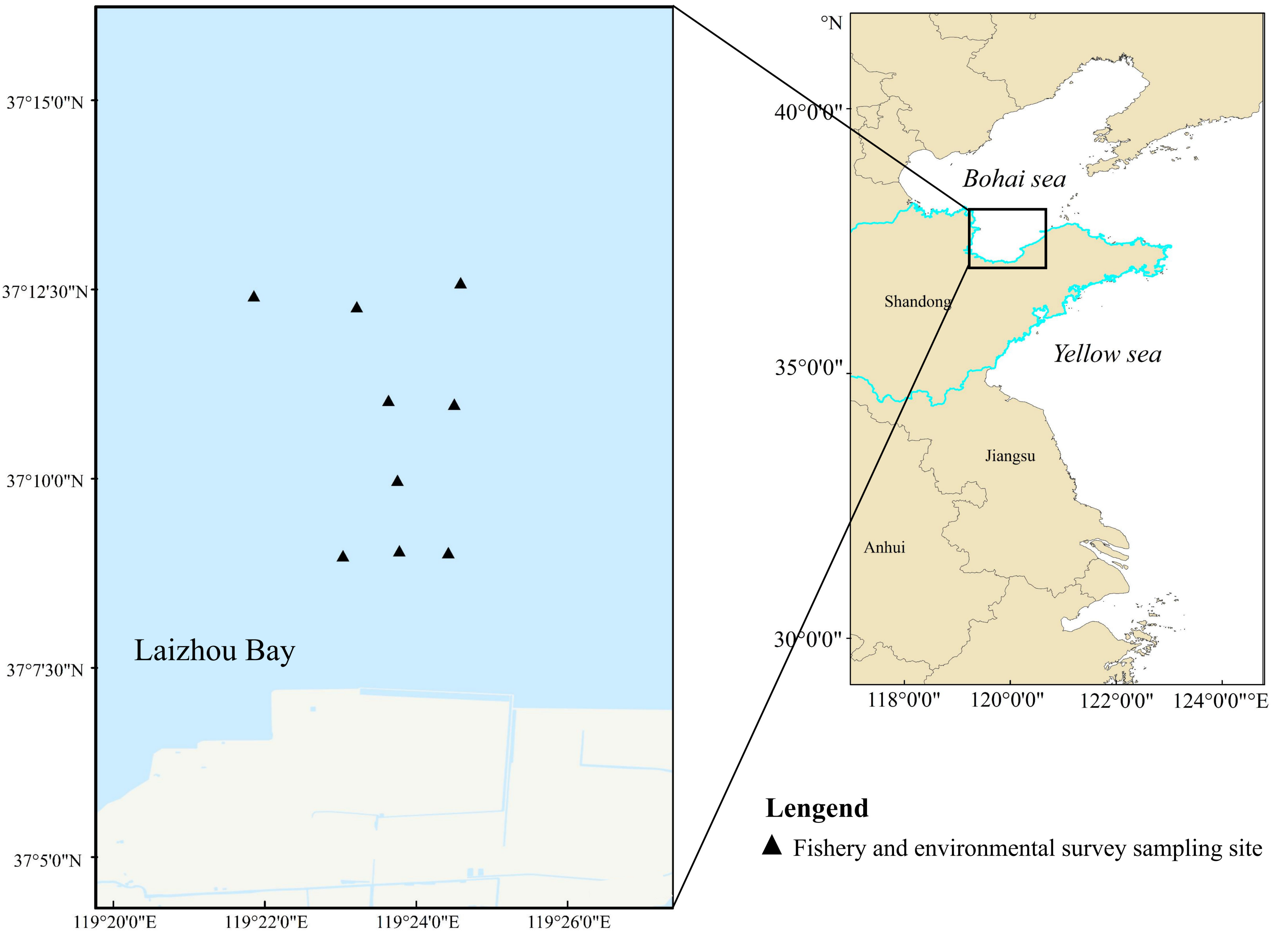
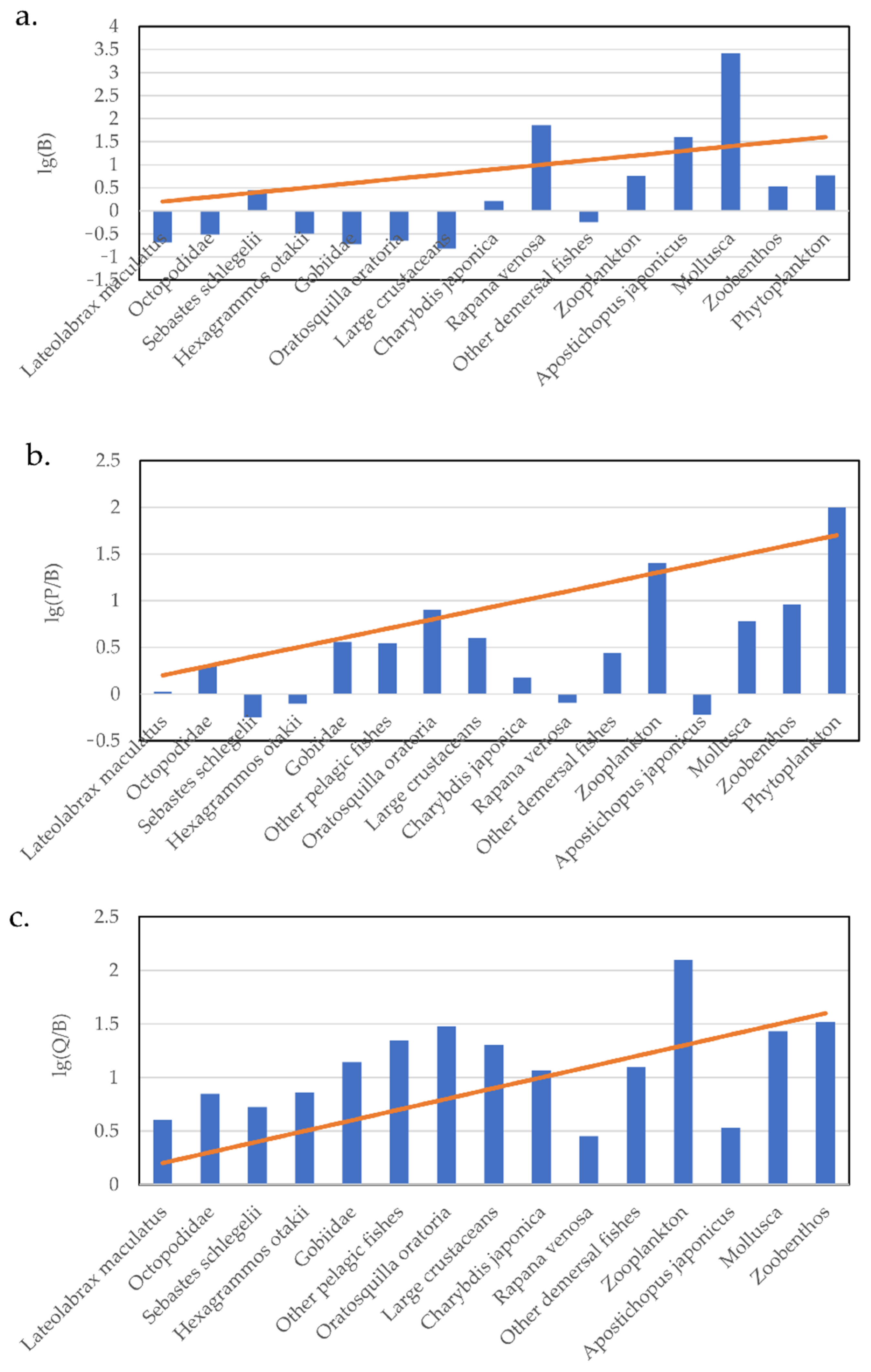
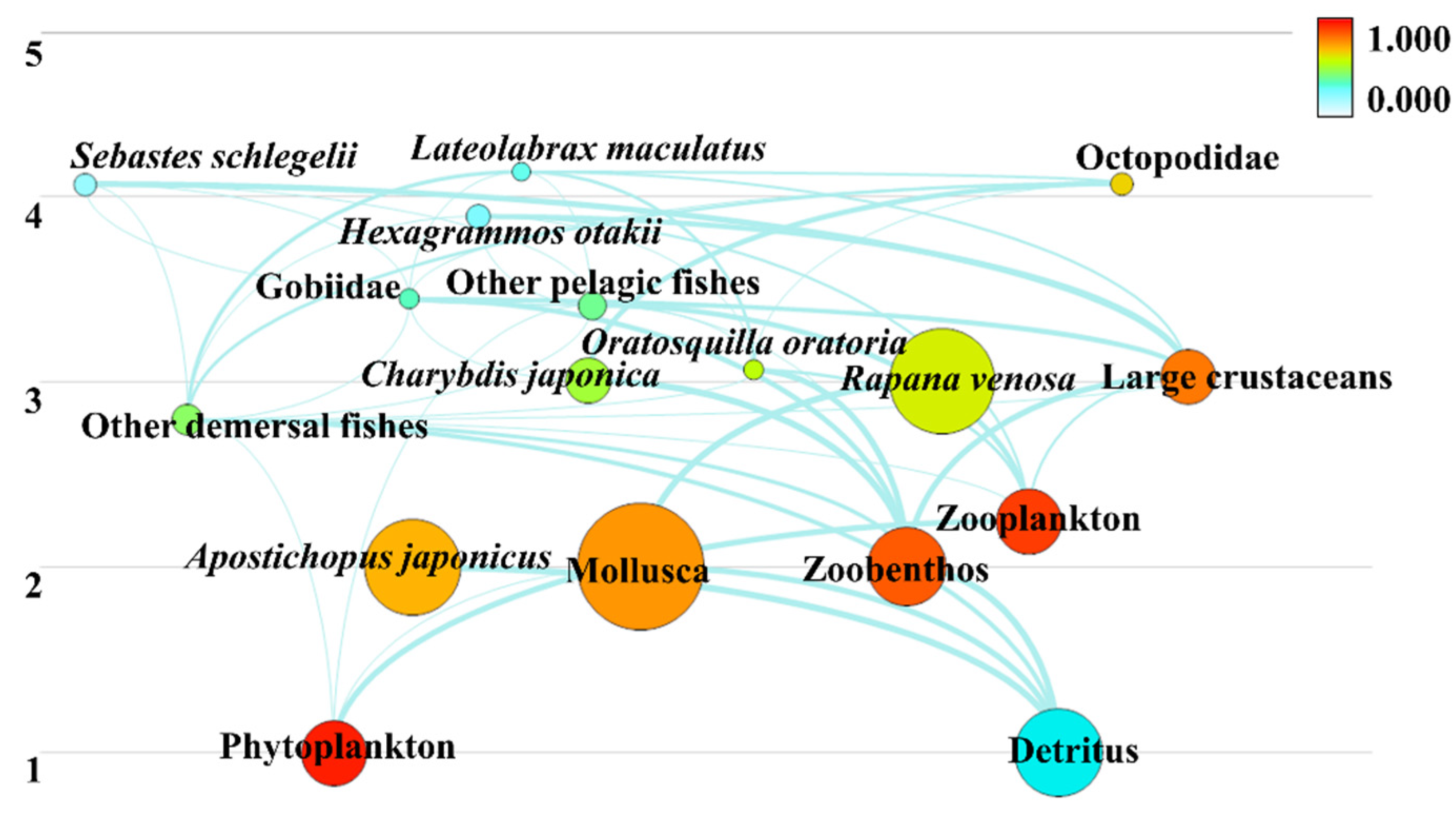
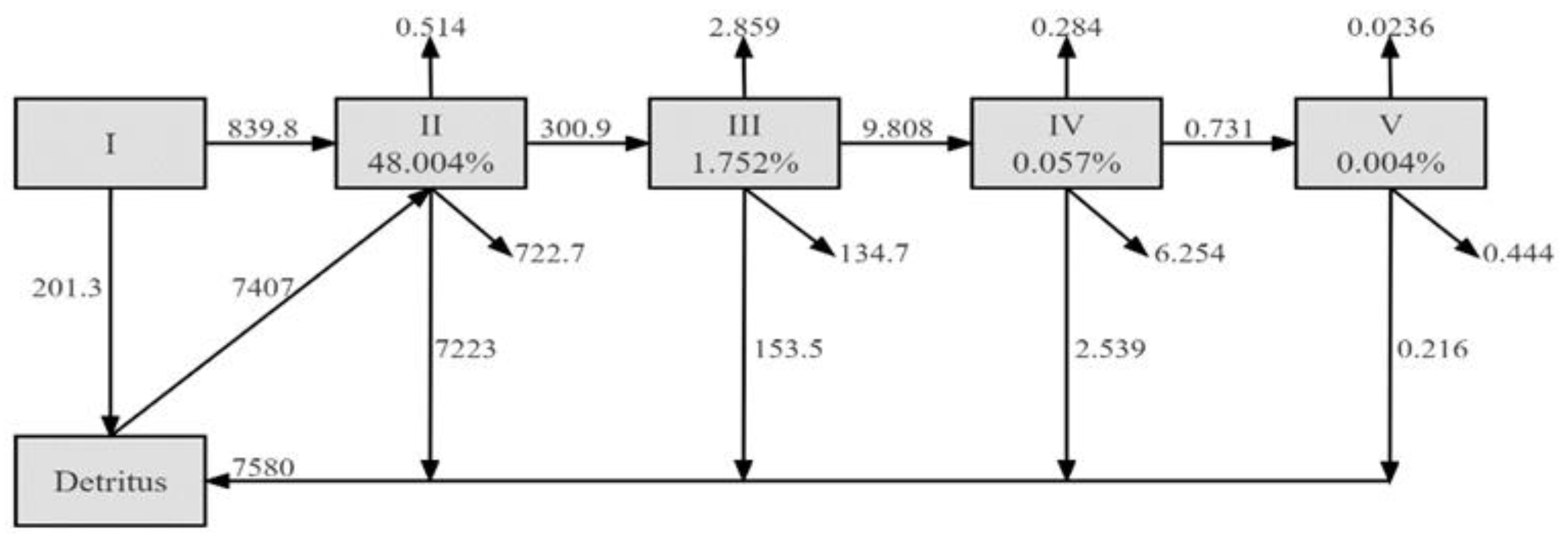
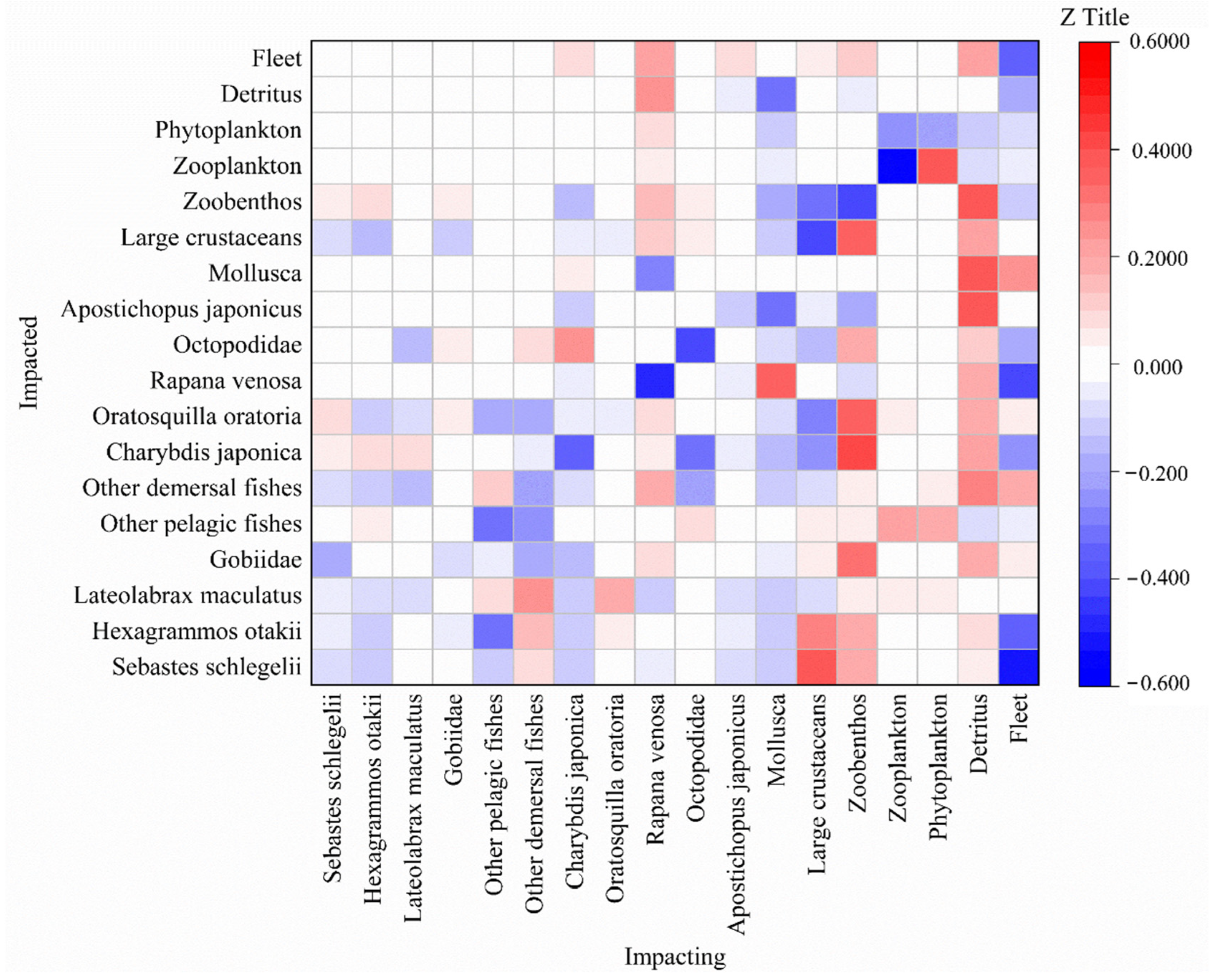
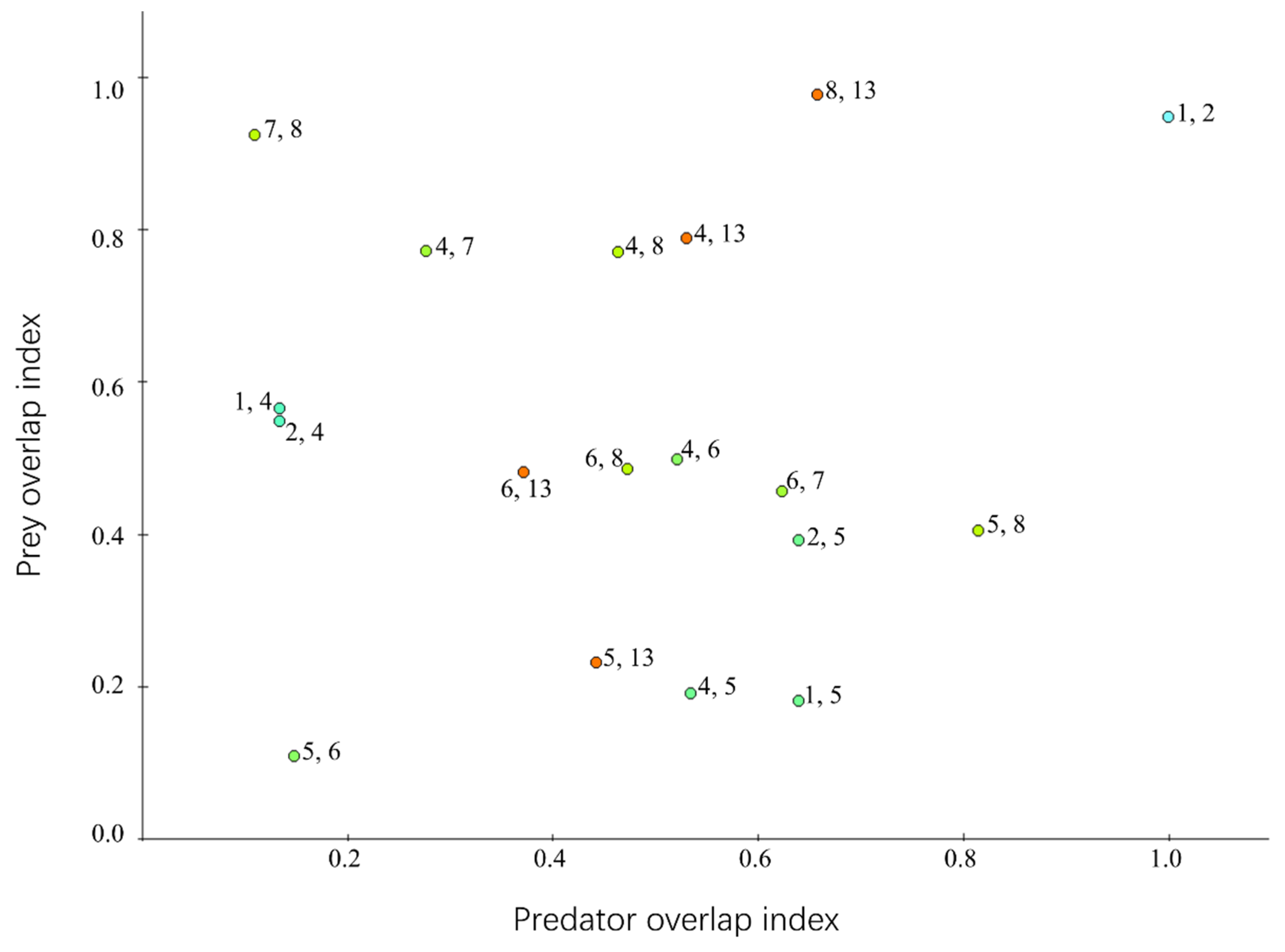
| Number | Functional Group | Group Description with Main Species |
|---|---|---|
| 1 | Sebastes schlegelii | Sebastes schlegelii |
| 2 | Hexagrammos otakii | Hexagrammos otakii |
| 3 | Lateolabrax maculatus | Lateolabrax maculatus |
| 4 | Gobiidae | Chaemrichthys stigmatias, Synechogobius ommaturus, Odontamblyopus rubicundus, Amblychaeturichthys hexanema, Acanthogobius flavimanus |
| 5 | Other pelagic fishes | Thryssa kammalensis, Scomberomorus niphonius, Konosirus punctatus, Sardinella zunasi, Sillago sihama, Setipinna tenuifilis, Argyrosomus argentatus, Johnius |
| 6 | Other demersal fishes | Paralichthys olivaceus, Enedrias fangi, Platichthys bicoloratus, Cynoglossus joyneri, Cynoglossus semilaevis, Platycephalus indicus, Platycephalus indicus, Sparus macrocephalus |
| 7 | Charybdis japonica | Charybdis japonica |
| 8 | Oratosquilla oratoria | Oratosquilla oratoria |
| 9 | Rapana venosa | Rapana venosa |
| 10 | Octopodidae | Octopus variabilis, Octopus ocellatus |
| 11 | Apostichopus japonicus | Apostichopus japonicus |
| 12 | Mollusca | Lamellibranchia, Gastropoda |
| 13 | Large crustaceans | Palaemon graviera, Trachypenaeus curvirostris, Arcania novemspinosa, Eucrate crenata, Dorippe japonica, Matuta planipes, Philyra pisumdeHaan, Paguridae |
| 14 | Zoobenthos | Prionospio pygmaea, Glyceraalba, Sternaspis scutata, Nephtys polybranchia, Chone infundibuliformis, Corophium, Neanthes succinea, Ehlersileanira izuensis, Magelona cineta, Scoloplos armiger, Ophelia acuminata, Ostrcpda unid., Ophiura kinbergi, Pionosyllis compacta, Ampelisca miharaensis, Melinna cristata, Ampelisca, Lumbrineris, Cleantis planicauda, Hemigrapsus penicillatus, Cossurella dimorpha, etc. |
| 15 | Zooplankon | Noctiluca miliaris, Pleurobrachia globosa, Paracalanus parvus, Paracalanus crassirostris, Centropages abdominalis, Centropages tenuiremis, Centropages dorsis, Labidocera bipinnata, Acartia pacifica, Corycaeus affinis, Caprella, Sagitta crassa, Oikopleura dioica, Polychaeta larvae, Copepoda larvae, Benthic Amphipoda, Caenorhabditis elegans, Acartia hongi, etc. |
| 16 | Phytoplanton | Bacillariophyta, Dinoflagellates, Chrysophyta |
| 17 | Detritus | Detritus |
| Num | Group | Trophic Level | Biomass | P\B | Q\B | EE | Landing | Unassim Consumptiom | P\Q |
|---|---|---|---|---|---|---|---|---|---|
| 1 | Sebastes schlegelii | 4.067 | 0.280 * | 0.558 | 5.980 | 0.747 | 0.093 * | 0.2 | 0.093 |
| 2 | Hexagrammos otakii | 3.893 | 0.322 | 0.785 | 8.190 | 0.225 | 0.033 [24] | 0.2 | 0.096 |
| 3 | Lateolabrax maculatus | 4.134 | 0.206 | 1.058 [31] | 4.000 [31] | 0.005 | 0.001 [31] | 0.2 | 0.264 |
| 4 | Gobiidae | 3.445 | 0.224 * | 3.600 [24] | 14.000 [24] | 0.856 | 0.032 [24] | 0.2 | 0.257 |
| 5 | Other pelagic fishes | 3.414 | 0.452 | 3.500 [24] | 22.10 [24] | 0.95 | 0.035 [31] | 0.2 | 0.158 |
| 6 | Other demersal fishes | 2.793 | 0.568 | 2.750 [34] | 12.50 [34] | 0.882 | 0.007 [31] | 0.2 | 0.220 |
| 7 | Charybdis japonica | 3.007 | 1.635 | 1.500 [24] | 11.60 [24] | 0.789 | 0.695 | 0.2 | 0.129 |
| 8 | Oratosquilla oratoria | 3.063 | 0.227 | 8.000 [24] | 30.00 [24] | 0.654 | 0.005 [24] | 0.2 | 0.267 |
| 9 | Rapana venosa | 3.000 | 71.67 | 0.800 [24] | 2.820 [24] | 0.023 | 1.297 | 0.2 | 0.284 |
| 10 | Octopodidae | 4.071 | 0.308 | 2.000 [24] | 7.000 [24] | 0.796 | 0.196 [24] | 0.2 | 0.286 |
| 11 | Apostichopus japonicus | 2.000 | 40.00 | 0.600 [24] | 3.360 [24] | 0.021 | 0.510 | 0.2 | 0.179 |
| 12 | Mollusca | 2.000 | 266.2 * | 6.000 [25] | 27.00 [25] | 0.127 | 0.7 | 0.222 | |
| 13 | Large crustaceans | 3.030 | 3.040 * | 4.000 [24] | 20.00 [24] | 0.558 | 0.780 [31] | 0.7 | 0.200 |
| 14 | Zoobenthos | 2.000 | 13.38 * | 9.000 [31] | 33.00 [31] | 0.681 | 0.7 | 0.273 | |
| 15 | Zooplankton | 2.250 | 5.757 | 25.00 [31] | 104.20 * [31] | 0.946 | 0.65 | 0.240 | |
| 16 | Phytoplankton | 1.000 | 5.784 | 180.00 * [24] | 0.807 | ||||
| 17 | Detritus | 1.000 | 25.35 | 0.977 |
| Energy Source | Trophic Level | |||
|---|---|---|---|---|
| II | III | IV | V | |
| Producer | 3.141 | 6.825 | 11.25 | 9.335 |
| Detritus | 3.713 | 3.959 | 10.17 | 9.709 |
| All flows | 3.655 | 4.210 | 10.34 | 9.627 |
| Proportion of total flow originating from detritus (%) | 89.0 | |||
| Transfer efficiencies from primary producers (%) | 6.224 | |||
| Transfer efficiencies from detritus (%) | 5.307 | |||
| Total transfer efficiencies (%) | 5.419 | |||
| Attribute Parameters | Value | V1 | V2 | V3 |
|---|---|---|---|---|
| Ecosystem properties | ||||
| Total consumption (CT)/t·km−2·year−1 | 8679.232 | 8681.018 | 8681.076 | 8680.367 |
| Total exports (TEX)/t·km−2·year−1 | 176.955 | 175.736 | 175.657 | 176.278 |
| Total respiratory flows (TR)/t·km−2·year−1 | 864.160 | 865.379 | 865.458 | 864.837 |
| Total flows into detritus (TDET)/t·km−2·year−1 | 7580.222 | 7579.003 | 7578.924 | 7579.545 |
| Total system throughput (TST)/t·km−2·year−1 | 17,300.57 | 17,301.14 | 17,301.12 | 17,301.029 |
| Net system production (NSP)/t·km−2·year−1 | 176.960 | 175.741 | 175.662 | 176.283 |
| Total production (TP)/t·km−2·year−1 | 3005.624 | 3005.833 | 3005.800 | 3005.855 |
| Total biomass (TB), excluding detritus/t·km−2 | 410.054 | 410.272 | 410.279 | 410.204 |
| Calculated total net primary production (TPP)/t·km−2·year−1 | 1041.120 | 1041.120 | 1041.120 | 1041.120 |
| Total catch/t·km−2·year−1 | 3.682 | 3.682 | 3.682 | 3.682 |
| Gross efficiency (catch/net p.p.) | 0.004 | 0.004 | 0.004 | 0.004 |
| Mean trophic level of the catch (TLc) | 2.969 | 2.969 | 2.969 | 2.969 |
| Ecosystem maturity | ||||
| Total primary production/total respiration (TPP/TR) | 1.205 | 1.203 | 1.203 | 1.204 |
| Total primary production/total biomass (TPP/TB) | 2.539 | 2.538 | 2.538 | 2.538 |
| Food web structure | ||||
| Connectance index (CI) | 0.207 | 0.207 | 0.208 | 0.208 |
| System omnivory index (SOI) | 0.090 | 0.090 | 0.090 | 0.085 |
| Finn’s cycling index (FCI) | 76.15 | 76.14 | 76.14 | 76.14 |
| Finn’s mean path length (FML) | 16.62 | 16.62 | 16.62 | 16.62 |
| Ascendancy (A)/% | 45.18 | 45.18 | 45.18 | 45.18 |
| System overhead (O)/% | 54.82 | 54.82 | 54.82 | 54.82 |
| Pedigree Index | 0.432 | 0.432 | 0.432 | 0.432 |
| The Target Species | Sebastes schlegelii | Hexagrammos otakii | Lateolabrax maculatus |
|---|---|---|---|
| Current biomass (t·km−2) | 0.280 | 0.322 | 0.206 |
| Multiples of ecological carrying capacity | 1.67 | 1.71 | 1.59 |
| Ecological carrying capacity (t·km−2) | 0.468 | 0.547 | 0.327 |
| Functional group with EE of 1 | Gobiidae | demersal fishes | demersal fishes |
| Ecological Indicator | This Work | Laizhou Bay (2016) [24] | Hangzhou Bay [44] | Beibu Gulf [41] | Haizhou Bay [43] | Jiaozhou Bay [42] |
|---|---|---|---|---|---|---|
| TST | 17,300.57 | 4697.276 | 19,323.00 | 8520.01 | 9549.47 | 12,917.10 |
| TPP/TR | 1.205 | 0.52 | 2.560 | 1.710 | 1.370 | 3.18 |
| CI | 0.207 | 0.208 | 0.310 | 0.333 | 0.39 | 0.310 |
| SOI | 0.09 | 0.164 | 0.350 | 0.198 | 0.18 | 0.160 |
| FCI | 76.15 | 22.52 | 25.00 | 9.73 | 10.96 | 2.47 |
| FML | 16.62 | 4.090 | 2.174 | 1.821 | 2.800 | 2.300 |
Publisher’s Note: MDPI stays neutral with regard to jurisdictional claims in published maps and institutional affiliations. |
© 2022 by the authors. Licensee MDPI, Basel, Switzerland. This article is an open access article distributed under the terms and conditions of the Creative Commons Attribution (CC BY) license (https://creativecommons.org/licenses/by/4.0/).
Share and Cite
Yuan, Y.; Feng, J.; Xian, W.; Zhang, H. Analysis of the Ecosystem Characteristics and Ecological Carrying Capacity of the Main Commercial Fish in the Artificial Reef Ecosystem in Laizhou Bay Using the Ecopath Model. Sustainability 2022, 14, 13933. https://doi.org/10.3390/su142113933
Yuan Y, Feng J, Xian W, Zhang H. Analysis of the Ecosystem Characteristics and Ecological Carrying Capacity of the Main Commercial Fish in the Artificial Reef Ecosystem in Laizhou Bay Using the Ecopath Model. Sustainability. 2022; 14(21):13933. https://doi.org/10.3390/su142113933
Chicago/Turabian StyleYuan, Yang, Jie Feng, Weiwei Xian, and Hui Zhang. 2022. "Analysis of the Ecosystem Characteristics and Ecological Carrying Capacity of the Main Commercial Fish in the Artificial Reef Ecosystem in Laizhou Bay Using the Ecopath Model" Sustainability 14, no. 21: 13933. https://doi.org/10.3390/su142113933
APA StyleYuan, Y., Feng, J., Xian, W., & Zhang, H. (2022). Analysis of the Ecosystem Characteristics and Ecological Carrying Capacity of the Main Commercial Fish in the Artificial Reef Ecosystem in Laizhou Bay Using the Ecopath Model. Sustainability, 14(21), 13933. https://doi.org/10.3390/su142113933






